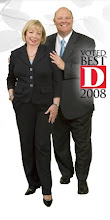The large organization often has a difficult time in building teams because there are more people. Larger teams are more difficult to form, manage, and control. With a smaller TEAM, there is more communication and interaction among TEAM members.
The “Big Boys” have a challenge in this regard. As teams get larger and the span of supervision gets broader, the time and effort to build a TEAM increases. While large organizations have more people, they are not necessarily better staffed. When a large organization builds its business plan around a large corporate staff and minimal line employees the level of service decreases at the operating level.
Less focus on TEAM results in more bickering, quarreling, and conflict. Clients, who believe that our TEAM is their TEAM, do not like conflict, bickering and quarreling. The smaller organization, with a better span of supervision and more frequent communications, has the ability to construct and maintain a TEAM atmosphere more easily.
To compete against the “Big Boys”, we should focus on TEAM building and strengthening the communications between TEAM members and clientele. This will support our contention that we have a unified group and that our TEAM members are working together to assist our clients.
For example, we might tell clients or prospects:
What are you doing to build TEAM in your organization?
Is “TEAM building” a priority or a lost art in your business?
How do you build involvement, interest, and participation with your TEAM?







